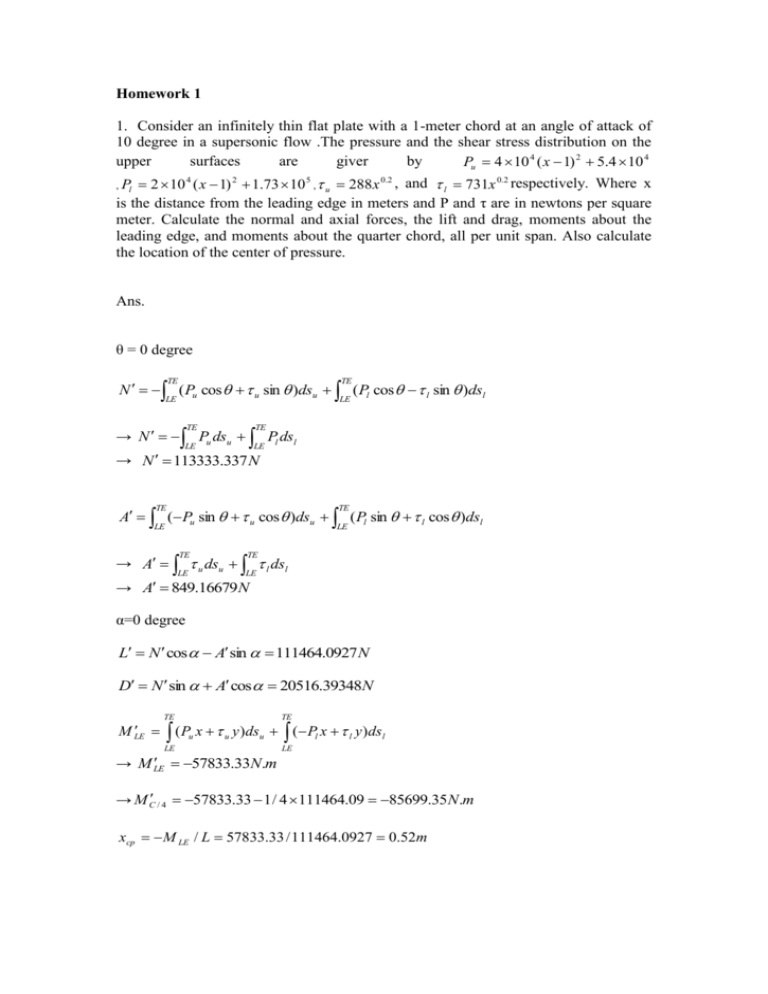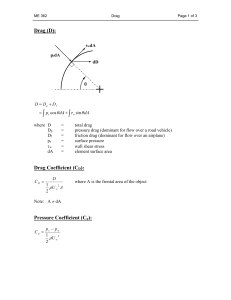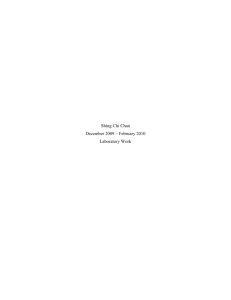coefficient arbitrary
advertisement

Homework 1 1. Consider an infinitely thin flat plate with a 1-meter chord at an angle of attack of 10 degree in a supersonic flow .The pressure and the shear stress distribution on the upper surfaces are giver by Pu 4 10 4 ( x 1) 2 5.4 10 4 2 10 4 ( x 1) 2 1.73 10 5 , u 288x 0.2 , and l 731x 0.2 respectively. Where x is the distance from the leading edge in meters and P and τ are in newtons per square meter. Calculate the normal and axial forces, the lift and drag, moments about the leading edge, and moments about the quarter chord, all per unit span. Also calculate the location of the center of pressure. , Pl Ans. θ = 0 degree TE TE LE LE N ( Pu cos u sin )dsu ( Pl cos l sin )dsl TE TE LE LE → N Pu dsu Pl dsl → N 113333.337 N TE TE LE LE A ( Pu sin u cos )dsu ( Pl sin l cos )dsl TE TE LE LE → A u dsu l dsl → A 849.16679N α=0 degree L N cos A sin 111464.0927N D N sin A cos 20516.39348N TE TE LE LE ( Pu x u y )dsu ( Pl x l y )dsl M LE 57833.33N.m → M LE → M C / 4 57833.33 1 / 4 111464.09 85699.35N .m xcp M LE / L 57833.33 / 111464.0927 0.52m 2. Consider an airfoil at 12 degree angle of attack. The normal and axial force coefficients are 1.2 and 0.03 respectively. Calculate the lift and drag coefficient. Ans. CN=1.2 , CA=0.03 → CL=CN cosα – CA sinα =1.167 → CD=CLsinα + CA cosα = 0.28 3. The shock waves on a vehicle in supersonic flight cause a component of drag called supersonic wave drag Dw . Define the wave drag coefficient as CD,w = Dw / q S , where S is a suitable reference area for the body. In supersonic flight, the flow is governed in part by its thermodynamic properties, given by the specific heats at constant pressure ,cp, and a constant volume ,cv . Define the ratio cp/cv = γ. Using Buckingham's pi theorem, show that CD,w= f ( M , γ).Neglect the influence of friction. Ans. Π1= qa . Sb. Dwc.Cpd = Ma+c L2b-a+c+2d T-2a-2c-2d → d=0,a=b=c=1 Π2=qa . Vb . Cpc .Cvd = Ma . L-a+b+2c+2d . T-2a-b-2c-2d. Kc+d → a=0 , b=0 ,c=1 ,d=-1 Π3=qa.Vb. Cpc.ad = Ma. L-a+b+2c++d. T-2a-b-2c-d. Kc → a=0 , b=1 , c=0 .d=-1 → CDW = f (M,γ) 4. Consider a circular cylinder in a hypersonic flow ,with it's axis perpendicular to the flow. Let φ be the angle measured between radial drawn to the leading edge (the stagnation point) and to any arbitrary point on the cylinder. The pressure coefficient distribution along the cylinder surface is given by Cp=2 cos2φ for 0 ≤ φ ≤ л/2 and 3л/2≤ φ ≤ 2 л and Cp=0 for л/2≤ φ ≤ 3 л/2. Calculate the drag coefficient for the cylinder. Based on the projected frontal area of the cylinder. Ans. CP= ( P-P∞)/q∞ D= ∫ dD = ∫ P cosθ ds = CP q∞ + P∞ P C p q P /2 C D 1 / 2 3 / 2 C p cos rd 4 / 3











